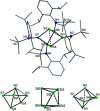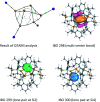A highly unsaturated six-vertex amido-substituted silicon cluster
- PMID: 32874511
- PMCID: PMC7448375
- DOI: 10.1039/d0sc01427c
A highly unsaturated six-vertex amido-substituted silicon cluster
Abstract
Thermal treatment of the bicyclo[1.1.0]tetrasilatetraamide [Si4{N(SiMe3)Dipp}4] 1 resulted in the formation of a highly unsaturated six-vertex silicon cluster [Si6{N(SiMe3)Dipp}4] 2 with only four amine-substituents and two ligand-free silicon atoms. In solution, a major and a minor conformer of this cluster are in equilibrium according to multinuclear NMR spectroscopy, lineshape analysis, DFT calculations and molecular dynamics simulations. The bonding situation in the highly unsaturated cluster features lone pair type character at the ligand-free silicon atoms and partial single and double bond character in the upper butterfly-shaped ring of 2. This allows to consider 2 as the silicon analogue of a butalene isomer.
This journal is © The Royal Society of Chemistry 2020.
Figures












References
-
- Sekiguchi A., Yatabe T., Kabuto C., Sakurai H. J. Am. Chem. Soc. 1993;115:5853.
- Abersfelder K., Russell A., Rzepa H. S., White A. J. P., Haycock P. R., Scheschkewitz D. J. Am. Chem. Soc. 2012;134:16008. - PubMed
-
- Abersfelder K., White A. J. P., Rzepa H. S., Scheschkewitz D. Science. 2011;327:564. - PubMed
-
- Abersfelder K., White A. J. P., Berger R. J. F., Rzepa H. S., Scheschkewitz D. Angew. Chem., Int. Ed. 2011;50:7936. - PubMed
-
- Moteki M., Maeda S., Ohno K. Organometallics. 2009;28:2218.
LinkOut - more resources
Full Text Sources

